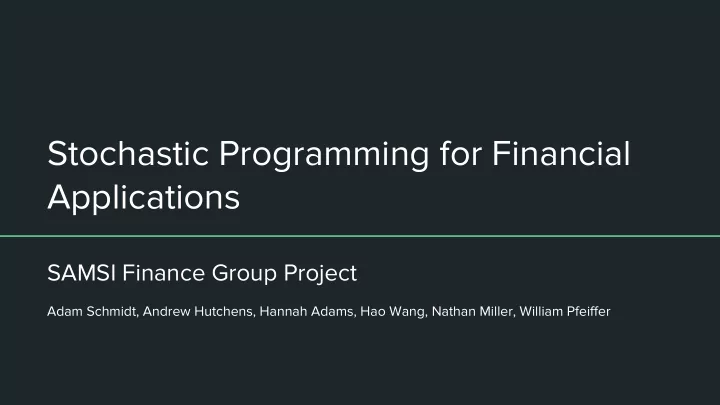

Stochastic Programming for Financial Applications SAMSI Finance Group Project Adam Schmidt, Andrew Hutchens, Hannah Adams, Hao Wang, Nathan Miller, William Pfeiffer
Agenda Our Results Limitations Portfolio Our and and Future Optimization Formulation Sensitivity Work Analysis
Financial Portfolios “A portfolio is a grouping of financial assets such as stocks, bonds and cash equivalents, as well as their funds counterparts, including mutual, exchange-traded and closed funds.” - Investopedia
Modern Portfolio Theory ● Illustrates optimal behavior of a single investor Assumes investor is risk-averse ○ ● Describes Expected Return-Variance of Returns Rule (EV Rule) ○ Returns are maximized/risk is reduced through diversification ○ Minimizing variance entails investing in stocks/securities with low covariance ● Efficient frontier Illustrates optimal portfolio & possible combos ○ ○ Highest expected returns for given risk Lowest risk for given expected return ○ ● Limitations ○ Investors will not be both rational and risk-averse ○ Investors may not have the same information ○ Investors don’t understand what returns are possible
Our Conceptual Formulation
Risk “The quantifiable likelihood of loss or ● less-than-expected returns” ● Return increases with risk ● Variance and covariance can be used to define the risk of investing in stocks ● Minimize risk or maximize return?
Random Simulation
Random Simulation Efficient Frontier
Stochastic Programming can find the portfolios along the efficient frontier given a set of stocks. Random Portfolios Stochastic Program
Stochastic Program Mathematical Formulation
Stochastic Program Implementation in Python 2.7 1. Data Collection a. Pandas, Datetime Packages b. Google Finance 2. Data Manipulation a. Calculated Average Daily Return b. Calculated Covariance Matrix c. Used Numpy 3. Optimization a. Quadratic Program in CVXOPT Package
Results - Risk/Return Matrix ● Optimized over three year period Jan 2014 - Dec 2016 Stocks considered: Apple, Google, Facebook, Kellogg, Dr. Pepper Snapple Group, Kate Spade, Bank of America, Bed Bath and Beyond, Stryker Corp, Ebay, Rocket Fuel
Results On average... ● The risk of portfolio is decreasing with increasing number of stocks considered for the portfolio ● The risk of our portfolio is increasing with increasing minimum allowable return
A Review of Portfolio Success in 2017 (Jan-May) ● Portfolio of 11 different stocks ○ Dr. Pepper Snapple Group, Google, Stryker Corp, Kellogg, Kate Spade, Facebook, Bank of America, Bed Bath and Beyond, Rocket Fuel, Ebay, Apple Portfolio 1 is least risky ● ● Portfolio 3 is most risky
Limitations of Our Work ● Do not determine the most optimal period to predict future portfolio success Only consider a maximum of 11 stocks ● ● May not define risk most optimally ● Model only uses past market data to predict future ● Dividends not considered
Future Work ● Determine a more accurate way to choose sample time period ○ Which time period we should work on considering the economic environment ○ How long the sample period should be, using the analysis of how well certain lengths of time have reflected the future in the past Measure the risk & return of the portfolio against appropriate benchmarks ● ● Improve the model by selecting stocks at random ○ Random selection eliminates selection bias Add more constraints ● ○ The weight on each stock could have a upper-limit ● Apply our portfolio method on other investing strategies ○ Based on “best” stock combination, analyse how to decide the investment proportion
Future Work ● Value at Risk (VaR) “VaR provides an estimate, under a given degree of confidence, of the size of a loss from a ○ portfolio over a given time period” We are 95% confident that we will lose no more than $10,000 in the next market day, or, we are ○ 5% confident that we will lose at least $10,000 in the next market day It is possible to compute value at risk using a Monte Carlo Simulation - VaR will be the ○ difference between current stock price and the estimated lowest terminal stock price If more time were available, many of these improvements could be ● implemented and fully tested in order to “optimize” our optimization method
Closing Remarks There are many methods one could implement in order to optimize a portfolio. The one we introduced is the method that we could devise, test, and analyze in the most complete way within the given time period. Thank you!
Questions? Contributors: ● Adam Schmidt; University of Wisconsin ● Andrew Hutchens; University of Central Florida ● Hannah Adams; University of North Carolina ● Hao Wang; Colorado State University ● Nathan Miller; Robert Morris University ● William Pfeiffer; Georgetown University Special Thanks: Peter Diao; SAMSI Post Doc
References Markowitz, Harry. “Portfolio Selection.” The Journal of Finance 7.1 (1952): 77-91. JSTOR . Web. 16 May 2017. “Efficient frontier.” Investopedia . 3 August 2016. Web. 16 May 2017. Rowland, Ron, and Brian Campos. "Is Modern Portfolio Theory Out-of-Date." Investing , Forbes, 19 May 2010, Rowland, R., & Campos, B. (2010, May 19). Is Modern Portfolio Theory Out-of-Date. In Forbes. Accessed 18 May 2017. "Calculating VaR using Monte Carlo Simulation." Finance Train. N.p., 31 Aug. 2011. Web. 18 May 2017. Halls-Moore, Michael. "QuantStart." Value at Risk (VaR) for Algorithmic Trading Risk Management - Part I - QuantStart. QuantStart, 7 July 2014. Web. 18 May 2017. "What Is An Investment Portfolio?" Money Choice. N.p., n.d. Web. 18 May 2017. "Basics of Investing, Financial Concepts." Basics of investing, Financial concepts, Risk return tradeoff. HSBC Global Asset Management, n.d. Web. 18 May 2017.
Recommend
More recommend